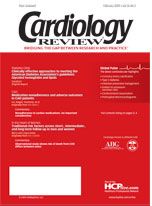Publication
Article
Cardiology Review® Online
Combination Rx achieves SBP goal in difficult-to-treat patients
Hypertension
San Francisco—More than three fourths of patients with difficult-to-control hypertension can achieve their systolic blood pressure (SBP) goal by use of a fixed-dose combination of irbesartan/hydrochlorothiazide (Avalide), according to data presented at the 20th Annual Scientific Meeting of the American Society of Hypertension.
Only one third of patients with hypertension have their blood pressure controlled to levels recommended in national guidelines, and 5 out of 10 treated hypertensive patients are not at goal blood pressure, said Elijah Saunders, MD, lead author of a study known as Irbesartan/HCTZ Blood Pressure Reduction in Diverse Patient Populations (INCLUSIVE). The blood pressure goal is less than 140/90 mm Hg, and less than 130/80 mm Hg for hypertensive patients with diabetes or chronic kidney disease, according to current national guidelines.
The study was conducted at 119 centers across the United States and included 1,005 patients with SBP uncontrolled on monotherapy. At least 100 patients were enrolled in each of several predefined subgroups, including African Americans, Hispanics/Latinos, those with metabolic syndrome, those with type 2 diabetes, or those 65 years or older.
“This was the first large-scale hypertension study to include such a broad range of patient groups,” said Dr. Saunders, professor of medicine, cardiology, and hypertension, University of Maryland, Baltimore.
After a placebo washout period, patients received hydrochlorothiazide, 12.5 mg/day, alone for 2 weeks, followed by
8 weeks of irbesartan/hydrochlorothiazide, 150/12.5 mg/day, and then 8 weeks of irbesartan/hydrochlorothiazide, 300/25 mg/day.
The mean change in SBP from baseline to week 18, the primary end point of the study, was —21.5 mm Hg, from 154.4 to 132.9 mm Hg. Seventy-seven percent of patients achieved their SBP goal. Diastolic blood pressure (DBP) was reduced by a mean of 10.4 mm Hg, from 91.3 to 80.9 mm Hg, and 83% of patients achieved their DBP goal.
More than half of the patients were
at their SBP goal 10 weeks into the study, when they had been treated with the lower dosage of irbesartan/hydrochlorothiazide.
SBP control rates were greater than 50% in each subgroup examined, and ranged from 56% in patients with type
2 diabetes to 82% in women. All other subgroups assessed (elderly, African American, Hispanic/Latino, metabolic syndrome, men) had SBP control rates in excess of 70%. DBP control rates ranged from 63% to 96%, with all subgroups except those with type 2 diabetes experiencing DBP control rates in excess of 70%.
“We showed that a more aggressive approach can take us from one third of patients controlled to 75% being controlled,” said study coauthor Joel Neutel, MD, associate clinical professor of medicine, University of California-Irvine. “The use of combination therapy earlier on in the management of hypertension will get more patients to goal. Using complementary drugs in combination makes it much easier to treat all subgroups of patients.”
The study was unique for three reasons, said Dr. Saunders. It was conducted in a general practice setting, it focused on SBP control, and it enrolled patients who were already receiving treatment but whose blood pressure was not controlled.
